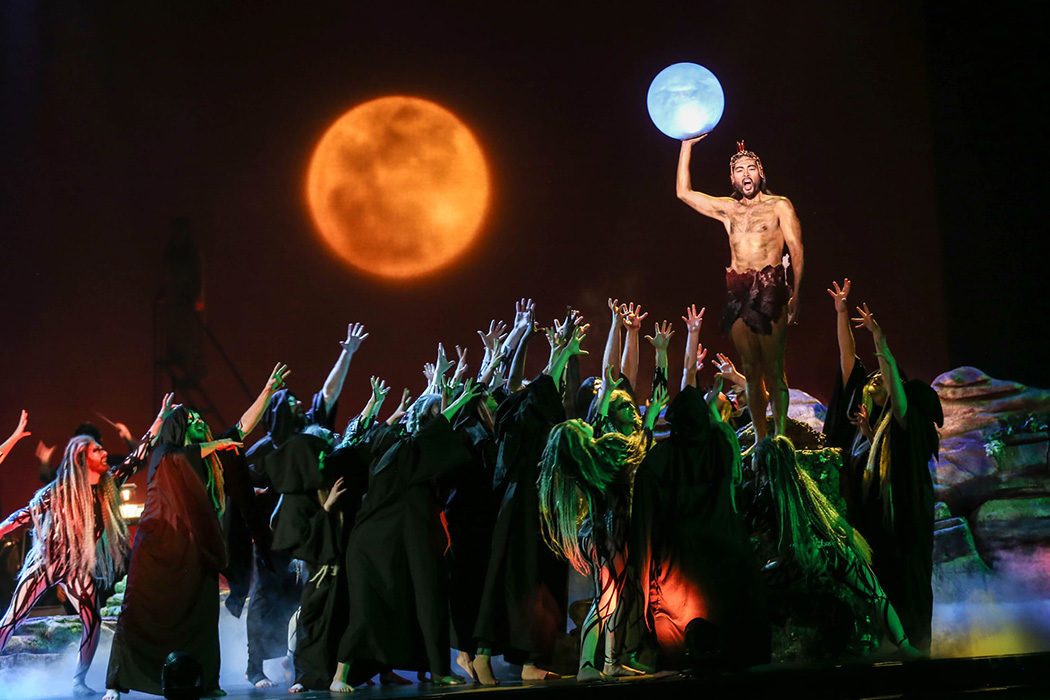After an absence of over two years from the performing stage, Knoxville Opera returned to life on Friday evening with a production of Arrigo Boito’s Mefistofele. Those two years have no doubt seemed like an eternity to Knoxville’s opera-goers who were visibly eager for the homecoming as they arrived at the Tennessee Theatre, despite still having to greet their opera friends with masked hellos and Covid-safe hugs. Nevertheless, this return had an important significance: Knoxville Opera was the last of the major performing organizations in Knoxville to return to live audience productions after the Covid shutdown eased.
For many of those opera-goers, though, the question was “Why Mefistofele?” Although Boito would have noteworthy work as a librettist for Verdi’s Otello and Falstaff, somewhat telling is the fact that Mefistofele was his only completed opera as a composer. And, along with the multiple reasons that the work is rarely performed, KO staged it only seven years ago. The opera is—admittedly—flawed in many ways, including a mostly unmemorable score that is saved by a few moments of vocal and choral beauty. The work’s length and scenic challenges practically demand significant cuts. While Boito’s libretto, based on Goethe’s Faust, makes some legitimate philosophical departures, the cutting renders the original source/legend almost unrecognizable; some necessary dramatic points of the story have been blurred or are missing. Yes, there is a reason that even New York City’s Metropolitan Opera has offered only two runs of Mefistofele performances in the last 100 years.
That question of “why” can be answered simply: the opera lends itself to a staging spectacle. And, this KO production was a delicious spectacle indeed. KO artistic director and conductor Brian Salesky and stage director Brian Deedrick have seized on and amplified that spectacle, repeating the 2015 production scheme that was attractive, distinctive, and successful in its visual and sonic appeal. The larger Knoxville Symphony Orchestra was moved out of the pit and onto an upstage position behind a scrim along with the substantial chorus for the prologue and epilogue. Additional brass instrumentalists were added in balcony positions. The elevator-driven stage apron of the Tennessee Theatre—normally the orchestra pit in the ‘down’ position—was then used as performance space and for clever scene changes. As in the 2015 production, the result was a mixture of movement, color, and sound on a massive scale that did what it could to overwhelm the work’s inherent flaws.
Of course, the devil is in the details of the opera’s casting. Finding a bass-baritone with vocal power and richness is the starting point. But equally important, the singer taking on Mefistofele must offer his own tantalizing spectacle—a shirtless display that gives meaning to the concept of temptation. KO found just such a singer in bass-baritone Hidenori Inoue. The singer possesses a warm, lithe voice that is full of charming smoothness throughout his range. However, Inoue is a marvelous actor, his Mefistofele quite devilish in his inability to understand humanity and quite comic in his attempts to escape the amorous clutches of the village girl, Marta. Inoue was able to turn his comfortable physicality into his character’s sensuousness, which allowed his voice to sell the character.
Tenor Kirk Dougherty turned in a very sympathetic Faust, both as an old man and as the handsome, transformed younger Faust, despite the role having had much of its dramatic depth compressed. Vocally, Dougherty brought an impassioned strength and attractive lyrical clarity to his mid-range and did not shy away from those impressive high-end moments of opportunity.
Making a Knoxville Opera debut was soprano Abigail Santos Villalobos in the role of Margherita, the naïve village girl whom Faust seduces and abandons. Villalobos’ command of the Act II prison scene was beautifully accomplished. Having been accused of poisoning her mother and drowning the baby she had with Faust, Margherita has gone insane. In her fragile state of mind and refusing rescue, her final aria,“L’altra notte in fondo al mare,” was chilling and stunning at the same time, the subtle lyrical coloratura appropriately understated.
As in the 2015 production, some non-essential scenes, such as the Act IV Helen of Troy scene, were cut, also eliminating some secondary roles. The two secondary roles remaining were Wagner, Faust’s pupil/assistant, sung and acted in spirited detail by Tim Pope—and Marta, the village girl enamored of Mefistofele, sung beautifully once again by Allison Deady.
Figuring prominently in the production’s spectacle were the choral forces of approximately 100 voices, drawing from the Knoxville Opera Chorus, the Knoxville Choral Society, Pellissippi State College Variations Ensemble, and the Knoxville Opera Youth Choir. Choreographer Brynn Yeager and Momentum Dance Lab injected clever movement energy and scale into the group scenes: the Easter Sunday village scene and especially the Brocken Mountain Witches’ Sabbath orgy. That latter scene was a feast for the eyes, as well as the ears, thanks to lighting designer John Horner and his bubbling cauldron of twisting, swirling saturated colors.
Given the mind-boggling logistics of this production—the technical and artistic aspects of orchestral, choral, and vocal balance, synchronization, moving elevators and scenery, and the subtleties of dramatic staging—one cannot help but admire the effort and idea behind this Mefistofele. The fact that one of Boito’s intentions with Mefistofele was to remind opera audiences of the musical culture present on Germany’s side of the Alps is perhaps something we should keep in mind for the future.






